
Mahindra & Mahindra Ltd., the Indian sports utility vehicle maker better known for its tractors and farm equipment, is betting on electric cars and digital services to revive its fortunes under new chief executive officer Anish Shah.
Shah, 51, has his task cut out for him. The $19 billion group’s SUV market share has plunged to 13%, from 50% seven years ago. It has struggled with failing investments and the pandemic’s blow to the automobile industry, which led it to report quarterly losses last year, its first in nearly two decades. Last week, it ended plans to collaborate with Ford Motor Co.
That’s all in the past, said Shah, who was previously Mahindra’s chief financial officer. “At this point I’m looking at it as more of a growth story rather than a turnaround story,” he said in an interview.
Shah is setting out a road map to revive the Mahindra Group, a 76-year-old conglomerate that is exiting money-losing businesses and writing down almost all losses in a restructuring. The executive, who has worked at the group for seven years, said its future growth will be underpinned by SUVs, electric vehicles and digital startups.
Investors appear to be on board. Mahindra’s shares have climbed 11% so far this year, outperforming the 3.9% gain for the benchmark S&P BSE Sensex.
Waiting List
With one in three cars sold in India being an SUV, regaining market share is critical for Mahindra, which gets more than 60% of its revenue from the automotive business. Shah is betting on its new Thar model, a four-wheel drive reminiscent of its earlier success Scorpio. The new model has a waiting list that stretches to early next year, in contrast to the tepid reception its mini van like the Marazzo or micro SUV like the KUV got from local customers.
“What we’ve learned is it doesn’t make sense to venture out of our core,” Shah said. “A core Mahindra SUV has the ability to be an off-roader while having the elegance to be driven around a city.”
India’s Farmers Give Mahindra (and Maybe Modi) a Sliver of
The conglomerate is also banking on electric vehicles as Shah sees them overtaking gas guzzlers by 2030. He will invest 30 billion rupees ($408 million) in EVs in the near term and launch electric variants of its SUVs, helped by its early purchase of an Indian electric carmaker in 2010.
Although Mahindra made early moves in the EV space, the market is getting crowded with a slew of manufacturers from Hyundai Motor Co. to Kia Motors Corp. offering their zero emission cars, while Tesla Inc. weighs its entry. But the lack of charging infrastructure and the high prices of EVs have slowed the shift from combustion engines.
BloombergNEF expects just one-third of new passenger cars sold in India to be battery-powered in 2040, compared with 70% in China and Germany.
Difficult Turnaround
The rebound in India’s overall car sales could also be dented by another wave of coronavirus spread, which has sparked curfews and lockdowns in parts of the country. Vaccine roll out has been slow — at this rate, it will take two and a half years to cover 75% of the population — possibly prolonging the weakness in consumer demand.
Higher Profits Seen for Indian Automakers as Demand Recovers
“Turnaround is possible but it’s going to be difficult,” said Mayur Milak, senior analyst at BOB Capital Markets. Mahindra needs to shed its “rural rugged player” image as the Indian market has moved to premium SUVs, while price-conscious buyers gravitate to compact SUVs. “Mahindra can’t afford to lose focus out of the SUV segment,” he said.
Shah is also looking beyond automobiles for growth, with plans to venture into digital startups that have potential to grow into unicorns.
Mahindra will rely on its new strategy to avoid bleeding cash, a lesson it took from having to sell a majority stake in Ssangyong Motor Co. after reeling for months under mounting losses. The company took an impairment charge of 12 billion rupees from Ssangyong in the quarter ended December. From now on, units must have a clear path to 18% return or strategic impact, or else it will exit, Shah said.
“Our focus on capital allocation isn’t over,” Shah said. “We would continue to have the financial discipline that will drive the prudence in deploying cash but beyond that it will also ensure our businesses stay on track from a returns standpoint.”